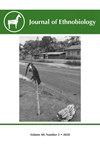Using Traditional Ecological Knowledge to Understand the Diversity and Abundance of Culturally Important Trees
IF 1.3
3区 社会学
Q1 ANTHROPOLOGY
引用次数: 11
Abstract
Abstract. Combining Indigenous traditional ecological knowledge (TEK) with scientific research holds promise for more effectively meeting community objectives for the conservation of cultural forest resources. Our study focuses on predicting the abundance of western redcedar trees (Thuja plicata) within the traditional territories of five Indigenous Nations that are part of the Nnwaolas Council in British Columbia, Canada. Indigenous people in this region use western redcedar extensively for cultural practices, such as carving dugout canoes, totem poles, and traditional buildings. However, after more than a century of industrial logging, the abundance of redcedar suitable for these types of practices is in decline and no longer reflects past baseline conditions. We assess how using TEK from interviews with Indigenous carvers refines predictions of resource abundance compared to using only conventional field surveys. Our findings reveal that western redcedar trees suitable for traditional carving are generally rare, and that some important growth forms, such as those associated with carving community canoes, are nearly extirpated from the landscape. We demonstrate a useful application of TEK in conservation planning and highlight concerns about the impact of industrial forestry on culturally important trees.利用传统生态知识认识重要文化树种的多样性和丰富性
摘要将土著传统生态知识与科学研究相结合,有望更有效地实现保护文化森林资源的社区目标。我们的研究重点是在加拿大不列颠哥伦比亚省的Nnwaolas理事会的五个土著民族的传统领土内预测西部红杉树(Thuja plicata)的丰度。该地区的土著居民广泛使用西部红杉进行文化活动,如雕刻独木舟、图腾柱和传统建筑。然而,经过一个多世纪的工业伐木,适合这种做法的红杉的丰度正在下降,不再反映过去的基线条件。我们评估了与仅使用传统实地调查相比,如何使用来自土著雕刻者访谈的TEK来改进资源丰度预测。我们的研究结果表明,适合传统雕刻的西部红杉树通常是罕见的,一些重要的生长形式,例如与雕刻社区独木舟有关的生长形式,几乎从景观中消失了。我们展示了TEK在保护规划中的有用应用,并强调了对工业林业对重要文化树木的影响的关注。
本文章由计算机程序翻译,如有差异,请以英文原文为准。
求助全文
约1分钟内获得全文
求助全文
来源期刊

Journal of Ethnobiology
Social Sciences-Anthropology
CiteScore
4.80
自引率
3.40%
发文量
21
审稿时长
>12 weeks
期刊介绍:
JoE’s readership is as wide and diverse as ethnobiology itself, with readers spanning from both the natural and social sciences. Not surprisingly, a glance at the papers published in the Journal reveals the depth and breadth of topics, extending from studies in archaeology and the origins of agriculture, to folk classification systems, to food composition, plants, birds, mammals, fungi and everything in between.
Research areas published in JoE include but are not limited to neo- and paleo-ethnobiology, zooarchaeology, ethnobotany, ethnozoology, ethnopharmacology, ethnoecology, linguistic ethnobiology, human paleoecology, and many other related fields of study within anthropology and biology, such as taxonomy, conservation biology, ethnography, political ecology, and cognitive and cultural anthropology.
JoE does not limit itself to a single perspective, approach or discipline, but seeks to represent the full spectrum and wide diversity of the field of ethnobiology, including cognitive, symbolic, linguistic, ecological, and economic aspects of human interactions with our living world. Articles that significantly advance ethnobiological theory and/or methodology are particularly welcome, as well as studies bridging across disciplines and knowledge systems. JoE does not publish uncontextualized data such as species lists; appropriate submissions must elaborate on the ethnobiological context of findings.
 求助内容:
求助内容: 应助结果提醒方式:
应助结果提醒方式:


